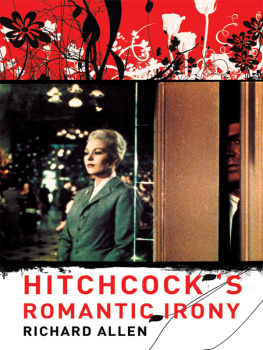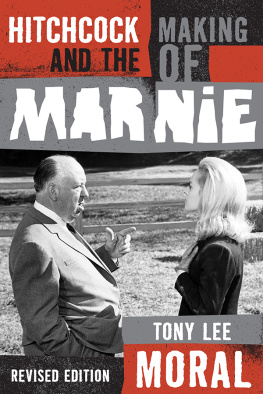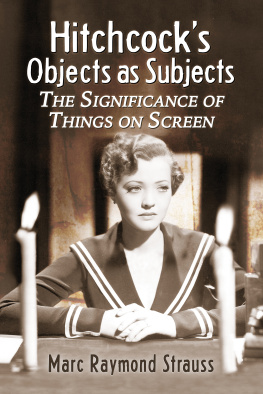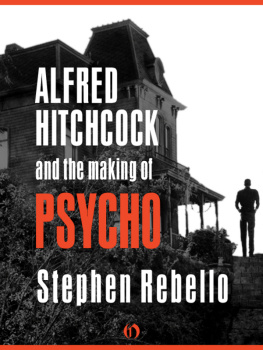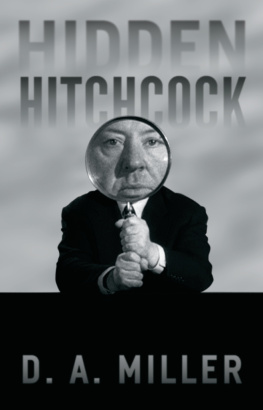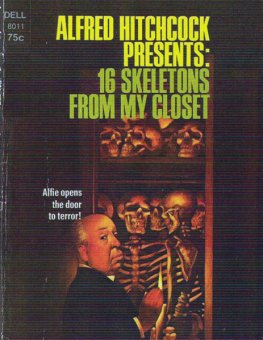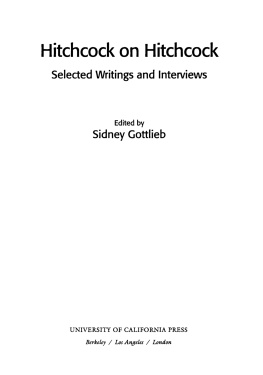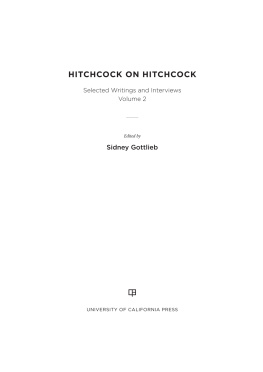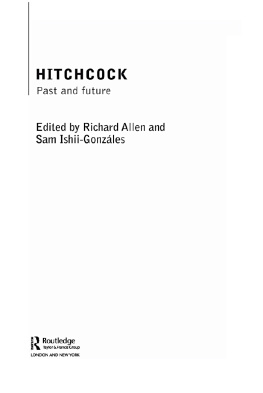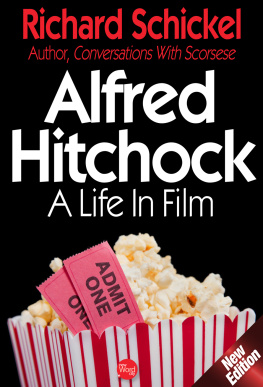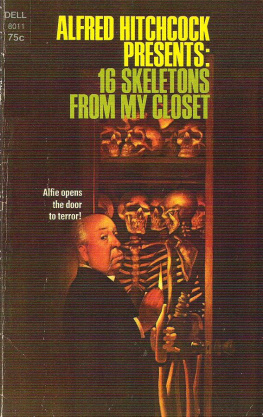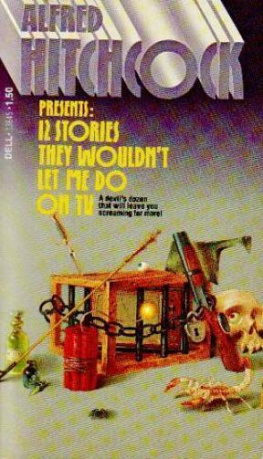Hitchcocks Romantic Irony
Film and Culture Series
John Belton, General Editor
Hitchcocks Romantic Irony
Richard Allen

Columbia University Press
New YorkColumbia University Press
Publishers Since 1893
New York Chichester, West Sussex
cup.columbia.edu
Copyright 2007 Columbia University Press
All rights reserved
E-ISBN 978-0-231-50967-1
Library of Congress Cataloging-in-Publication Data
Allen, Richard, 1959
Hitchcocks romantic irony / Richard Allen.
p. cm.(Film and culture)
Includes bibliographical references and index.
ISBN 978-0-231-13574-0 (cloth : alk. paper)ISBN 978-0-231-13575-7
(pbk. : alk. paper)ISBN 978-0-231-50967-1 (ebook)
1. Hitchcock, Alfred, 18991980Criticism and interpretation. I. Title. II. Series.
PN1998.3.H58A73 2007
791.430233092dc22
2007012808
A Columbia University Press E-book.
CUP would be pleased to hear about your reading experience with this e-book at .
Reproduction of color stills was made possible with a generous grant from the Tisch School of the Arts, New York University.
Portions of the following work have been published in slightly different form and are reprinted with the permission of the editors and publishers: Hitchcock, or the Pleasures of Metaskepticism," October 89 (Summer 1999): 6986; The Lodger and the Origins of Hitchcocks Aesthetic," Hitchcock Annual (20012002): 3878; Hitchcock and Narrative Suspense: Theory and Practice," in Richard Allen and Malcolm Turvey, eds., Camera Obscura, Camera Lucida: Essays in Honor of Annette Michelson (Amsterdam: Amsterdam University Press, 2003); Daphne du Maurier and Alfred Hitchcock," in Robert Stam and Alessandra Raengo, eds., A Companion to Film and Literature (New York: Blackwell, 2004), 298325; and Sir John and the Half-Caste: Identity and Representation in Hitchcockss Murder!," Hitchcock Annual 13 (20042005): 92126.
In memory of
Tom Keavy (19912003)
Their faces were not made for wrinkles, their
Pure blood to stagnate, their great hearts to fail.
The blank grey was not made to blast their hair,
But like the climes that know nor snow nor hail
They were all summer: lightning might assail
And shiver them to ashes, but to trail
A long and snake-like life of dull decay
Was not for themthey had too little clay.
LORD BYRON
Contents
In America you respect him because he shoots scenes of love as if they were scenes of murder. We respect him because he shoots scenes of murder like scenes of love. Anyway, its the same man we are talking about, the same man, and the same artist.
FRANOIS TRUFFAUT
It seemed to me, as much from certain precise points made in the conversation as from statements gathered from Hitchcocks collaborators, that he had a permanent notion of mise-en-scne, that of a tension in the interior of a sequence, a tension that one would not know how to reduce either to dramatic categories or plastic categories but which partakes of both at the same time. For him it is always a question of creating in the mise-en-scne, starting from the scenario, but mainly by the expressionism of the framing, the lighting, or the relation of the characters to the dcor, an essential instability of image. Each shot is thus for him like a menace, or at least an anxious waiting. One recognizes at a glance the most banal still from one of his films, in the admirably determined quality of this disequilibrium.
ANDR BAZIN
For over ten years I have regularly taught Alfred Hitchcocks films in a university setting, and more recently I have edited, with my colleague Sid Gottlieb, the Hitchcock Annual, a journal of Hitchcock Studies." My thinking about Hitchcocks work has been shaped, for better or worse, by these experiences, in particular by my attempt to digest the plurality of commentaries his work has supported and spawned since the critics of Cahiers du cinma first acknowledged his significance as a director in the 1960s. Hitchcocks work has yielded critical approaches as divergent as the argument of Lesley Brill, who understands Hitchcock as an essentially conventional director of romances," and queer theorist" Lee Edelman, who conceives of Hitchcocks films as an attack on heteronormativity." The Hitchcock criticism of Robin Wood is actually self-divided between his first book, which views Hitchcocks films as therapeutic in their effect, confronting us with the dark side of human existence in order to affirm conventional morality, and his later writings, which understand Hitchcock as a critic of conventional morality, particularly as it is embodied in the values of heterosexual romance. Unless these critics are completely misguided rather than simply selectively biased, there are surely properties of Hitchcocks films that explain this divide, that can explain how it is that Hitchcocks works yield the divergent interpretations that they do.
Of course, part of the explanation for this contrasting emphasis and selective bias" in critical writings on Hitchcock stems from the fact that studies of Hitchcock are often driven by a specific theoretical or ideological agenda wherein the critic discovers in the works of Hitchcock what he or she wants to see in them and disregards the potential counterexamples. This problem is compounded by the fact that critics of Hitchcock often discuss at most a dozen or so filmsand frequently fewerout of the fifty-three feature films he made during his long career. I began my research on Hitchcock by setting out to write a book that would be structured around individual films or groups of films, and this research has resulted in a number of published essays that I refer to from time to time in this volume. However, as I conceived the broader contours of the project in response to the wide range of literature in the field, I began to think of this book in terms of a series of thematically organized chapters that encompass a greater span of Hitchcocks work.
The problem of selective bias" is not simply one of the scope of critical inquiry, but of the nature of critical inquiry, where film criticism is primarily conceived of as an activity of interpretation. I do not agree with David Bordwell that interpretation is intrinsically an act of making" (rather than discovering") meaning; however, I do agree that it is an activity that is prone to the making of meaning, especially when interpretation is conceived as a practice that exists to confirm a theory which the critic applies to the text. In bad interpretation meaning is made; in good interpretation meaning is discovered. One test of a good interpretation is the agreement that a good interpretation commands from informed viewers, while a bad interpretation largely reflects back from a film the assumptions of the critic. While I would not wish to see the activity of interpretation abandonedindeed, I regularly practice it in the pages of this bookI agree with Bordwell that interpretation must be answerable to the practice of what he calls poetics" in order to yield critical insights of lasting value.
Poetics is not primarily an interpretative practice, but a practice of descriptive generalization that clarifies the patterns of style (what are the cinematic ways in which Hitchcocks story is conveyed?); content and theme (what kinds of stories does Hitchcock tell and what are his recurring motifs?); and form (how does Hitchcock structure the spectators experience of his stories?). There are many places where description meets interpretation. Even in such a simple case as characterizing what happens in a story, one often needs to interpret what one sees and hears in order to understand it: for example, what exactly happens in the memory" flashback which concludes Hitchcocks film
 Columbia University Press New York
Columbia University Press New York
